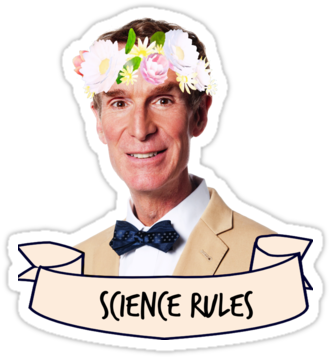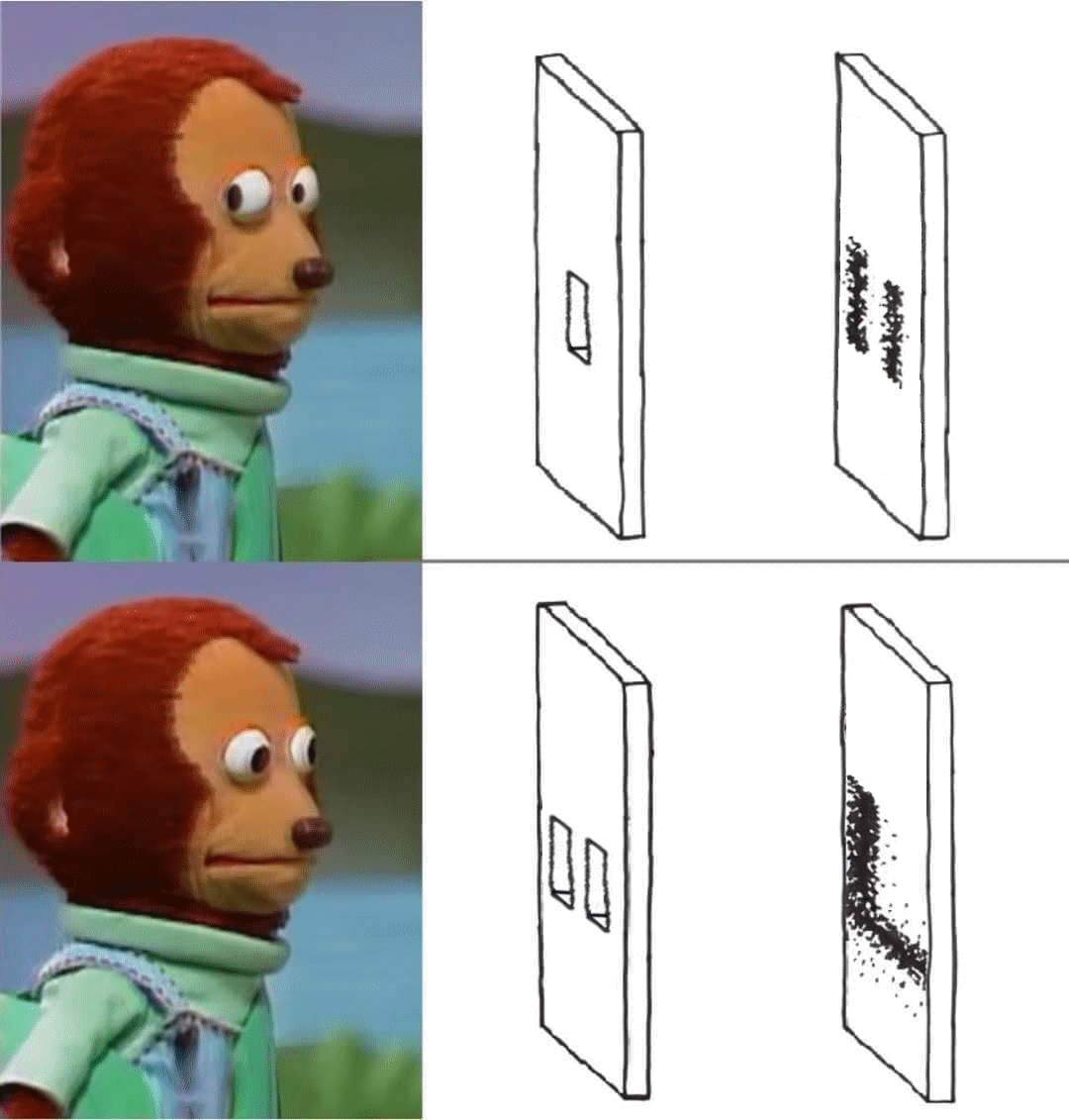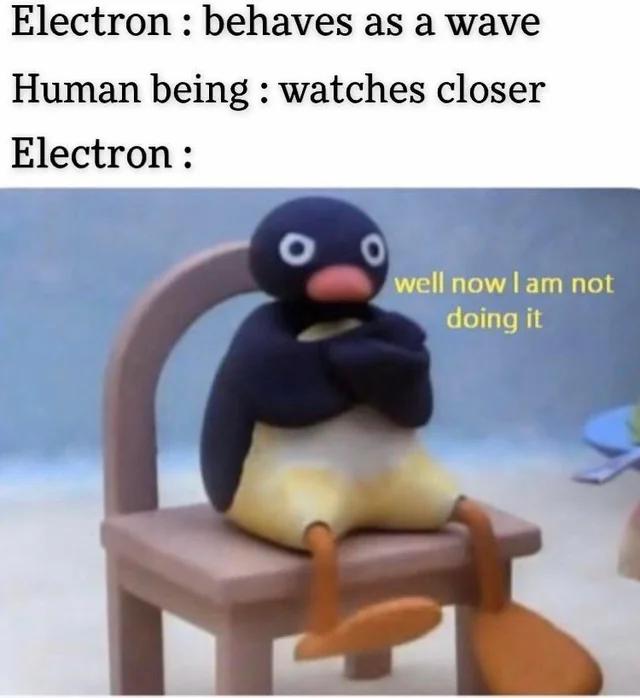
Science Memes
Welcome to c/science_memes @ Mander.xyz!
A place for majestic STEMLORD peacocking, as well as memes about the realities of working in a lab.

Rules
- Don't throw mud. Behave like an intellectual and remember the human.
- Keep it rooted (on topic).
- No spam.
- Infographics welcome, get schooled.
This is a science community. We use the Dawkins definition of meme.
Research Committee
Other Mander Communities
Science and Research
Biology and Life Sciences
- [email protected]
- [email protected]
- [email protected]
- [email protected]
- [email protected]
- [email protected]
- [email protected]
- [email protected]
- [email protected]
- [email protected]
- [email protected]
- [email protected]
- [email protected]
- [email protected]
- [email protected]
- [email protected]
- [email protected]
- [email protected]
- [email protected]
- [email protected]
- [email protected]
- [email protected]
- [email protected]
- [email protected]
- !reptiles and [email protected]
Physical Sciences
- [email protected]
- [email protected]
- [email protected]
- [email protected]
- [email protected]
- [email protected]
- [email protected]
- [email protected]
- [email protected]
Humanities and Social Sciences
Practical and Applied Sciences
- !exercise-and [email protected]
- [email protected]
- !self [email protected]
- [email protected]
- [email protected]
- [email protected]
Memes
Miscellaneous
Seeing your comment inspired me to make this

I lost it.
Holy shit, that's incredible.
This makes me irrationally angry
Then don't look at it
Now I'm just more angry...
Yes, so we've observed
But then they wouldn't be angry right? Or would they be both angry and happy?
I just imagined someone who's smiling only while being looked at, and making an angry face otherwise. Perfect nightmare fuel
Im not going to explain this again... OK!... its not looking, its measure that changes the result of the experiment. To measure implies interaction.
I think the meme is just poking fun at the physics behind the whole thing, but in case anyone doesn’t know:
It’s called the observer effect, and it happens because:
This is often the result of utilizing instruments that, by necessity, alter the state of what they measure in some manner.
And particularly in the double-slit experiment:
Physicists have found that observation of quantum phenomena by a detector or an instrument can change the measured results of this experiment.
https://en.wikipedia.org/wiki/Observer_effect_(physics)
So for anyone who wants to have a surface understanding of the observer effect, the wiki does a fair job of the basic explanation.
Yep, the observer it is not only observing, it is interacting in order to measure.
I'd read a piece that even just having a camera present has the same effect.
That's not really it. You need something that measures the state of the electron. Merely looking in the direction is not enough. It has to be something that interacts with the electron.
A camera alone isn't enough. But light (eg photons) with enough energy should be enough. But then that energy will manipulate the electron. If you had a completely dark room and pointed a camera at the experiment it wouldn't change anything.
It's kind of like having your cake and eating it too.
Yeah, it turns out that slapping the electron around like with a big stick or whatever causes it to change its behavior, go figure! :-P
Dammit Jim, I'm a psychologist, not a physicist!
It isn't "looking" that is meant by "observation". "Observation" is meant to convey the idea that something (not necessarily sentient) is in some way interacting with an object in question such that the state(s) of the object affects the state(s) of the "observer" (and vice versa).
The word is rather misleading in that it might give the impression of a unidirectional type of interaction when it really is the establishment of a bidirectional relationship. The reason one says "I observe the electron" rather than "I am observed by the electron" is that we don't typically attribute agency to electrons the way we do humans (for good reasons), but they are equally true.
Edit: a way of putting it is that the electron can only be said to be in a particular state if it matters in any way to the state of whomever says it. If I want to know what state an electon is in, it must appear to me in some state in order for me to get an answer. If I never interact with it, I can't possibly get such an answer and the electron then behaves as if it was actually in more than one state at once, and all those states interfere with each other, and that looks like wavelike patterns in certain measurements.
Edit 2: just to be clear, I used an electron as an example, but it's exactly the same for anything else we know of. Photons, bicycles, protons, and elephants are all like this, too. It's just that the more fundamental particles you involve and the more you already know about many of them, the fewer the possible answers are for any measurement you could make.
So you're telling me the people from The Secret lied to me?!
I have no idea what that is so I'll just go with yes, probably!
No, the electron only understands sentient thoughts, if a camera or an animal looks at it, it won't work.
Well that's not right
Physicists have found that observation of quantum phenomena by a detector or an instrument can change the measured results of this experiment. Despite the "observer effect" in the double-slit experiment being caused by the presence of an electronic detector, the experiment's results have been interpreted by some to suggest that a conscious mind can directly affect reality.[3] However, the need for the "observer" to be conscious (versus merely existent, as in a unicellular microorganism) is not supported by scientific research, and has been pointed out as a misconception rooted in a poor understanding of the quantum wave function ψ and the quantum measurement process.[4][5][6]>
I suspect it was a joke. Can't be sure though.
I'm pretty confident it's a joke, but clearly from other comments people may actually believe something like that. It's best someone corrects it, even if not for the sake of the poster.
Not just sentient, but intelligent thought. I proved it in university. When I setup the lab, I got no interference pattern. When my more intelligent labmate did the setup there were fringes.
Wait! That means I was the sentient one! I was cheated! (Or maybe I just sucked at lab.)
Maybe consciousness is fundamental and matter and spacetime are derived from it
edit: this comment is a bit controversial to people just want to say why not explore this idea we spent over 50 years on string theory where has that gotten us
Donald Hoffman Ted talk on consciousness
Please just take the time to learn more before you come at me lol
Consciousness has literally nothing to do with it. In fact, the experiment as demonstrated in this emem would not replicate the double slit results. What has to happen is something along the path has to interfere with the photon (aka observe, which has nothing to do with consciousness, rather just an interaction), which causes the waveform to collapse. Basically, if something needs to know the state, the state collapses into one result. It doesn't matter what that thing is.
You need to qualify that statement somehow, or maybe give a citation or source that supports such an idea
It's really frustrating that people who don't understand this experiment have insanely taken into assume that a magic particle spell understands if a human being is watching or not.
Perhaps it would be better to explain why instead of attempting a mic drop based on your superior knowledge?
It’s called the observer effect, and it happens because:
This is often the result of utilizing instruments that, by necessity, alter the state of what they measure in some manner.
And particularly in the double-slit experiment:
Physicists have found that observation of quantum phenomena by a detector or an instrument can change the measured results of this experiment.
https://en.wikipedia.org/wiki/Observer_effect_(physics)
So for anyone who wants to have a surface understanding of the observer effect, the wiki does a fair job of the basic explanation.
The interference disappearing from measurement is not really because the instrument alters the state. Or, at least, putting it like that occludes the more fundamental reason.
Fundamentally, measurements are subject to the uncertainty principle, which dictates that one can not define precisely the values of two complementary observables at the same time. Position and momentum of any quantum object are such complementary observables, so measuring one -- for example position -- requires that the other (momentum) becomes less defined.
When the position of a particle is narrowed down to a pixel on a detector screen, its momentum becomes very uncertain and we must talk about all the possible paths for it to have arrived at that point.
The probability of a particle being measured at any given pixel is given by the probability of all possible paths combined[^1], with this important quirk: when combining possible quantum states, they interfere with each other, constructively or destructively. Repeated measurements of positions give you what appears to be wave-like interference due to the way the probabilities of all paths interfere.
By checking which slit a particle passes through, you exclude all the possible paths through the other slit and end up not observing the same pattern because the two slits simply do not interfere.
[^1]: To be more precise, by "combining" I mean state vector addition. Probability is magnitude squared of a quantum state vector. So for a given position, you take all possible paths there, sum their state vectors, then square the resulting vector's norm (magnitude) to get its probability. The sum of all positions' individual probabilities will be exactly one - meaning that it will always be somewhere.
In short
😐 = Electron if you look
 = Electron if you don't look
= Electron if you don't look
*Photon
